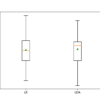Machine learning models are chosen based on their mean performance, often calculated using k-fold cross-validation. The algorithm with the best mean performance is expected to be better than those algorithms with worse mean performance. But what if the difference in the mean performance is caused by a statistical fluke? The solution is to use a […]










